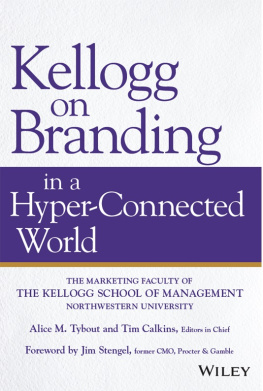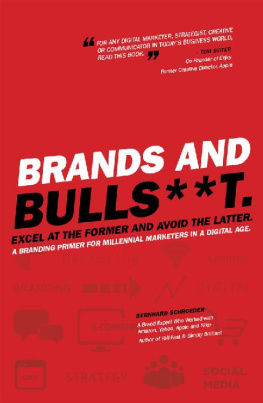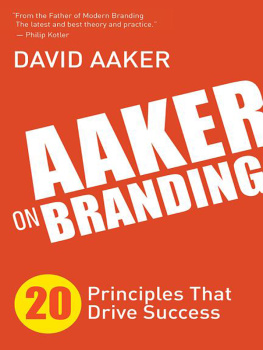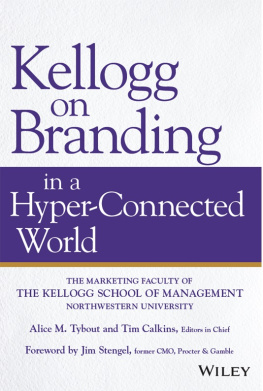Table of Contents
Copyright 2005 by Alice M.Tybout and Tim Calkins. All rights reserved.
Published by John Wiley & Sons, Inc., Hoboken, New Jersey.
Published simultaneously in Canada.
No part of this publication may be reproduced, stored in a retrieval system, or transmitted in any form or by any means, electronic, mechanical, photocopying, recording, scanning, or otherwise, except as permitted under Section 107 or 108 of the 1976 United States Copyright Act, without either the prior written permission of the Publisher, or authorization through payment of the appropriate per-copy fee to the Copyright Clearance Center, Inc., 222 Rosewood Drive, Danvers, MA 01923, (978) 7508400, fax (978) 646-8600, or on the web at www.copyright.com. Requests to the Publisher for permission should be addressed to the Permissions Department, John Wiley & Sons, Inc., 111 River Street, Hoboken, NJ 07030, (201) 748-6011, fax (201) 748-6008, or online at http://www.wiley.com/go/permissions.
Limit of Liability/Disclaimer of Warranty: While the publisher and author have used their best efforts in preparing this book, they make no representations or warranties with respect to the accuracy or completeness of the contents of this book and specifically disclaim any implied warranties of merchantability or fitness for a particular purpose. No warranty may be created or extended by sales representatives or written sales materials.The advice and strategies contained herein may not be suitable for your situation.The publisher is not engaged in rendering professional services, and you should consult with a professional where appropriate. Neither the publisher nor author shall be liable for any loss of profit or other commercial damages, including but not limited to special, incidental, consequential, or other damages.
For general information on our other products and services please contact our Customer Care Department within the United States at (800) 7622974, outside the United States at (317) 5723993 or fax (317) 572-4002.
Designations used by companies to distinguish their products are often claimed by trademarks. In all instances where the author or publisher is aware of a claim, the product names appear in Initial Capital letters. Readers, however, should contact the appropriate companies for more complete information regarding trademarks and registration.
Wiley also publishes its books in a variety of electronic formats. Some content that appears in print may not be available in electronic books. For more information about Wiley products, visit our web site at www.Wiley.com.
Library of Congress Cataloging-in-Publication Data:
Kellogg on branding : the marketing faculty of the Kellogg School of
Management / edited by Alice Tybout and Tim Calkins ; foreword by Philip
Kotler.
p. cm.
ISBN-13 978-0-471-69016-0 (cloth) ISBN-10 0-471-69016-3 (cloth)
1. Brand name products. 2. Brand name productsMarketing. 3. Brand name productsManagement. 4. Customer relationsManagement. I. Tybout, Alice M. II. Calkins,Tim. III. Kellogg School of Management.
HD69.B7K46 2005
658.827dc22
2005007457
FOREWORD BY PHILIP KOTLER
In an age of hypercompetition, commoditization, globalization, and rapid technological obsolescence, marketers are struggling to find new conceptual bases on which to design and deliver their marketing programs. The haunting truth is that traditional marketing is not working. Top management now sees many mass advertising campaigns as losing money. They see sales promotion campaigns as boosting sales temporarily but being largely unprofitable. They experience direct mail campaigns as barely delivering a 1 percent response rate. Their new products are failing at a disturbing rate.
There are two answers to the marketing challenge facing todays companies. One is to know your customers better and to get closer to them. The other is to differentiate your offering through your branding work so that the offering stands out as relevant and superior in value to a clear target market.
The power of creative branding is visible to all. We are drawn to Starbucks, Harley-Davidson, Coca-Cola, Apple Computer, Singapore Airlines, Heinz, Gillette, Porsche. These companies have learned how to make their brands live in customers minds and hearts.
Branding is much more than attaching a name to an offering. Branding is about making a certain promise to customers about delivering a fulfilling experience and a level of performance. Therefore, branding requires that everyone in the supply chainfrom product development to manufacturing to marketing to sales to distributionworks to carry out that promise. This is what is meant by living the brand. The brand becomes the whole platform for planning, designing, and delivering superior value to the companys target customers.
The Kellogg School of Management enjoys its ranking as the number-one business school and the number-one marketing department due to its relentless research and teaching regarding what helps companies become superior performers in the marketplace. We have taught the principles and practices of marketing and branding to countless generations of MBA students who are now plying their craft in the worlds leading companies.
In this book, we offer our version of what goes into brewing successful brands. We have invited our experts to describe the foundations of branding, the strategies for building and leveraging brands, and the task of moving from strategy to implementation. As a coup de grce , we have asked market leaders to describe their actual experiences in developing and marketing their brands.
Most companies take the easy road to marketing their brands by buying a lot of expensive advertising, making clich claims, and spending lavishly on sales promotion. We see branding instead as the foundation of deep market planning. We offer this book as a treasure trove of ideas for bringing new life to your brands.
PREFACE
Prior to 2003, the Kellogg School of Management didnt offer any courses or executive education programs on the topic of branding. The issue wasnt that the faculty thought branding was unimportant. Rather, we thought branding was so important and encompassing that it was incorporated into almost every marketing class and executive education program offered by the school. So when people asked for a branding program, they were directed to consumer marketing, or business-to-business marketing, or another course based on their specific situation and need.
This changed in 2003, when the Kellogg School decided that the time was right to launch a program focused solely on issues related to branding. Interest in branding was high and growing, as companies recognized the critical role brands played in driving profitable, long-term growth. More important, it was clear that executives were looking for help on the specific topic of creating and managing brands. Many managers understood that brands were essential, but they didnt know where to turn for skills in this particular area. With this in mind, the Kellogg School introduced a new executive education program, Kellogg on Branding.
Response to the program was remarkably strong; the first sessions quickly sold out, and the participants were excited about the material. As we explored this response, we learned two things. First, branding is becoming a focus for more and more companies. The managers in our first sessions of Kellogg on Branding were remarkably diverse; they came from the pharmaceutical, financial services, apparel, building materials, and technology industries. Our participants included lawyers and doctors and teachers. Many of these individuals were being asked to think about brands for the first time. Second, while the world is full of branding agencies and branding books, there are few resources that combine academic theory and practical application. These two insights inspired us to develop this book.












